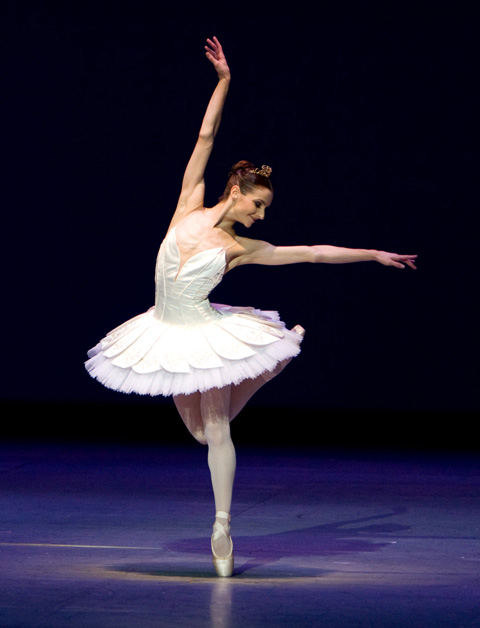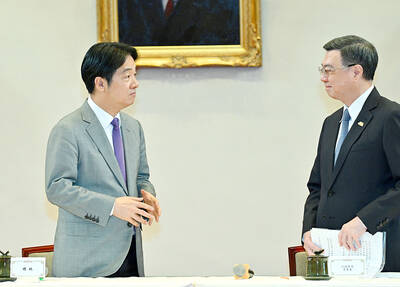Capitalizing on the success of their inaugural gala program last July, Taiwanese ballerina Wang Tzer-shing (王澤馨) and ballet impresario Paul Seaquist began planning the 2008 International Ballet Star Gala almost before the ovations finished last year.
Despite an array of injuries over the past two months that took out several of their original lineup, including Ronald Savkovic and Sue-jin Kang and even one of the replacements, Wang and Seaquist have come up with a roster of principal dancers and soloists that will make both balletomanes and the average dance fan happy. Wang also upped the stakes this year, moving the show from the International Convention Center theater to the National Theater — and expanding it from one night to two. The length of the program has also meant an earlier starting time, 7pm.
While some of the dancers might not be well known to Taipei audiences, there will be some familiar faces — Leonid Sarafanov and Olesia Novikova, who have appeared here with the Kirov Ballet — and Shoko Nakamura of the Berlin State Ballet, who appeared in last year’s gala. The other ballerinas are Miki Hamanaka, Ivy Amista, Diana Cuni, Maria Yakovleva and Tiit Helimets and the danseurs are Daniil Simkin, Giuseppe Picone, Tigran Mikayelyan, Alessio Carbone, Robert Tewsley and Tan Yuan Yuan.

PHOTO COURTESY OF IBSG GROUP
This year’s international gala truly lives up to its billing as the nationalities of the dancers and their companies they work for reflect just how cosmopolitan even national companies have become in the past decade or so. The dancers hail from Brazil, Italy, Denmark, Estonia, Armenia, Japan, Russia and China and they dance for troupes in Germany, Lithuania, Italy, Russia, Austria and the US.
Much of this year’s program is a repeat of the bravura warhorses seen last year (though with different dancers) — the grand pas de deux from Le Corsaire, Don Quixoite, Giselle, Les Sylphide, Sleeping Beauty — mixed with those from less familiar ballets such as John Cranko’s Romeo and Juliet and Kenneth MacMillan’s exquisite Manon.
There are also excerpts from George Ballenchine’s vast output, a pas de deux from his classic Apollo, the Tchaikovsky Pas de Deux he created in 1960 and the whimsical Who Cares?, set to George Gershwin songs.
Wang said it was the dancers themselves who set the program, based on their individual repertoires.
“The dancers make the choice, what they would like to do ... . We just ask them to do one classical piece and one contemporary,” she said.
Among the contemporary works, there is Russian-born, San Francisco-based dancer/choreographer Yuri Possokhov’s 1999 ballet Magrittomania, which explores the world of Belgian surrealist Rene Magritte; and Belgian-born, Wiesbaden-based choreographer Ben Van Cauwenbergh’s funny, technically demanding solo Les Bourgeois, set to the music of Jacques Brel.
There will also be a world premiere, The Human Within, choreographed by Eduard Nikita, which will be danced by Amista and Mikayelyan.
“The Human Within is electrifying,” Wang said. “Nikita is quite a new choreographer, but he is getting a reputation in Germany.”
Pulling together such a disparate array of talent has been a logistical nightmare.
“It’s been crazy. The flight schedules, the dancers’ schedules with their companies,” Wang said yesterday. “For example, the Kirov dancers came in last night [Wednesday], the dancer from Vienna [Yakovleva] came in this afternoon but she’s on stage now rehearsing and the Kirov pair go back on the 23rd and they have a performance at home that night. I don’t know how they can do it.”

Under pressure, President William Lai (賴清德) has enacted his first cabinet reshuffle. Whether it will be enough to staunch the bleeding remains to be seen. Cabinet members in the Executive Yuan almost always end up as sacrificial lambs, especially those appointed early in a president’s term. When presidents are under pressure, the cabinet is reshuffled. This is not unique to any party or president; this is the custom. This is the case in many democracies, especially parliamentary ones. In Taiwan, constitutionally the president presides over the heads of the five branches of government, each of which is confusingly translated as “president”

Sept. 1 to Sept. 7 In 1899, Kozaburo Hirai became the first documented Japanese to wed a Taiwanese under colonial rule. The soldier was partly motivated by the government’s policy of assimilating the Taiwanese population through intermarriage. While his friends and family disapproved and even mocked him, the marriage endured. By 1930, when his story appeared in Tales of Virtuous Deeds in Taiwan, Hirai had settled in his wife’s rural Changhua hometown, farming the land and integrating into local society. Similarly, Aiko Fujii, who married into the prominent Wufeng Lin Family (霧峰林家) in 1927, quickly learned Hoklo (commonly known as Taiwanese) and

The Venice Film Festival kicked off with the world premiere of Paolo Sorrentino’s La Grazia Wednesday night on the Lido. The opening ceremony of the festival also saw Francis Ford Coppola presenting filmmaker Werner Herzog with a lifetime achievement prize. The 82nd edition of the glamorous international film festival is playing host to many Hollywood stars, including George Clooney, Julia Roberts and Dwayne Johnson, and famed auteurs, from Guillermo del Toro to Kathryn Bigelow, who all have films debuting over the next 10 days. The conflict in Gaza has also already been an everpresent topic both outside the festival’s walls, where

The low voter turnout for the referendum on Aug. 23 shows that many Taiwanese are apathetic about nuclear energy, but there are long-term energy stakes involved that the public needs to grasp Taiwan faces an energy trilemma: soaring AI-driven demand, pressure to cut carbon and reliance on fragile fuel imports. But the nuclear referendum on Aug. 23 showed how little this registered with voters, many of whom neither see the long game nor grasp the stakes. Volunteer referendum worker Vivian Chen (陳薇安) put it bluntly: “I’ve seen many people asking what they’re voting for when they arrive to vote. They cast their vote without even doing any research.” Imagine Taiwanese voters invited to a poker table. The bet looked simple — yes or no — yet most never showed. More than two-thirds of those